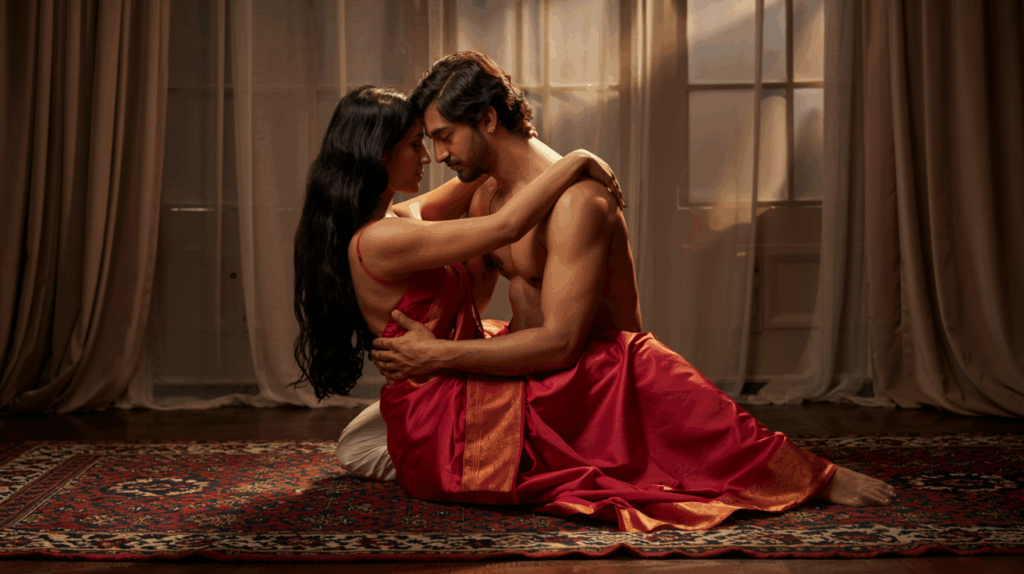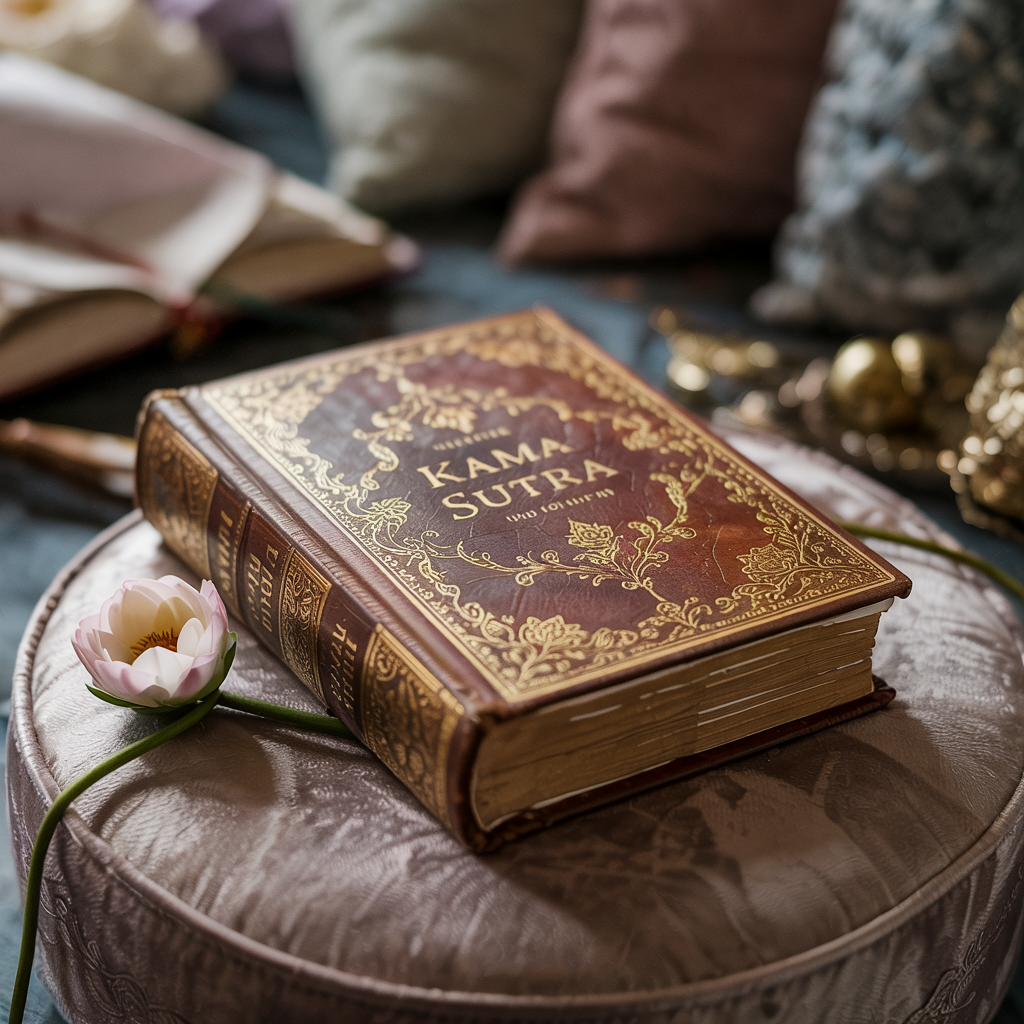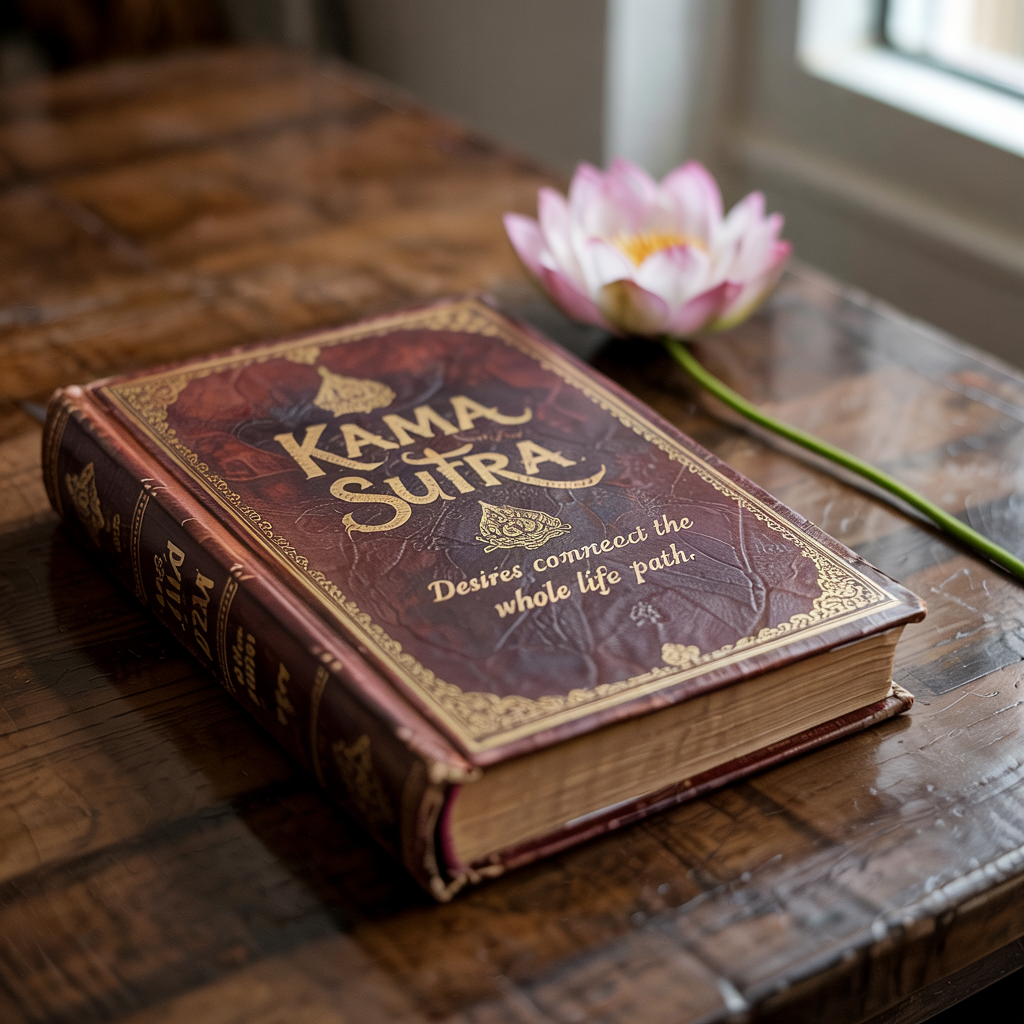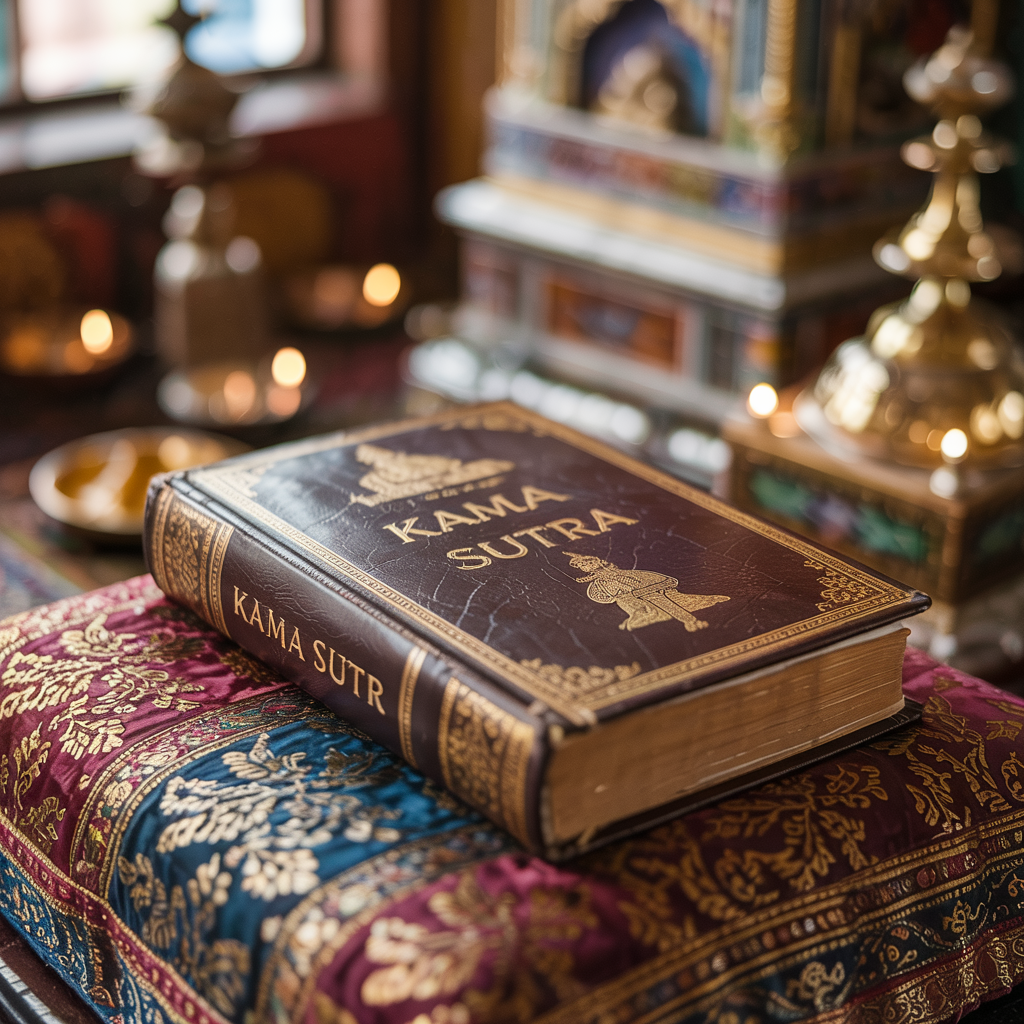
Key points
- It guides human life, love, and building good relationships. The book has seven parts that discuss topics such as finding a life partner, marriage, and the art of living well.
- Its purpose was to help people lead a balanced life. It focuses on the three goals of Hindu life: Dharma (virtue), Artha (wealth), and Kama (pleasure).
- The modern view of the Kama Sutra often misses its deeper meaning. While it does describe various sexual positions, it also covers courtship, marriage, family life, and social conduct.
Contents
Kama Sutra

Kama Sutra is one of those books everybody’s heard of but no one has read.
Many people think that the Kama Sutra is all about sex positions – it’s a guide to living well. Kama Sutra: A New, Complete and Illustrated Edition by Alain Daniélou talks about balancing pleasures, success, and spiritual growth.
Daniélou’s book helps the modern reader understand the author. His translation shows how the Kama Sutra fits into Indian life and thought.
The Kama Sutra was written in Sanskrit and discusses matters of acquiring a wife, leading a happy domestic life, and sex.
Historical Context and Origin

Indian culture experienced a golden age when the Kama Sutra flourished and progressed. The creator of the Kama Sutra is not the originator of all the ideas- he is the one who organized these ideas.
During that time educated people believed that one should focus on three things in life – dharma (duty), artha (success), and kama (pleasure). The Kama Sutra focuses on this third goal.
Historian Wendy Doniger said: “The Kama Sutra assumes a world of urban polish; in its ideal world, men and women move in circles of poetry, music, and the arts (Doniger, 2003).”
Purpose and Significance in Ancient India

In ancient Indian times the Kama Sutra was a handbook for a rounded life in India. Old people did not hide or shame physical pleasure. It was seen as one of the aspects that made for a good life. T
he book taught upper-class men about succeeding in every sphere of life: love, marriage, or otherwise. It taught techniques for accessing good partners and producing lasting unions.
It also describes social manners, city life, arts, and more. It is like a capsule that shows how people lived and what was on their minds thousands of years ago.
Philosophical Foundations

Desires connect the whole life path. Kama Sutra is misunderstood; it is not just a manual of sexy postures. It shows how all our desires are linked to our entire life trajectory. This prepares us for looking at pleasure in the broader perspective of our whole life plan.
Definition and Scope of Kama
Kama means desire in its fullest sense. It goes beyond sex. It includes essentially everything that we take pleasure in through our senses and thinking.
It includes art, music, food, scents, and touch. It curates strategies for leading a rich life through pleasures and allows us to see that pleasure belongs in a properly good life.
Relationship between Dharma, Artha, and Kama
The Kama Sutra fits kama into a trio of life goals. The three of these are dharma (virtue), artha (wealth), and kama (pleasure). They need to work together; none should take over.
We live well when these three stay in balance. Dharma guides our moral choices. Artha gives us the means to live. Kama brings joy to life. They create a full human experience.
Role of Kama in Human Life
Kama plays a vital role in our lives. It sees pleasure as natural and good when used right.
Kama Sutra teaches how to seek pleasure skillfully. Random pursuit of desires leads to harm but carefully pursuing them adds benefit to life.
It helps us grow as full humans. It connects us to others. A life lacking proper pleasure is an incomplete life. It helps us find joy in being human.
The Art of Living

Alain Daniélou’s Kama Sutra: A New, Complete and Illustrated Edition is not just for sex. It talks a lot about how to live well.
Guidelines for a Balanced Life
The Kama Sutra gives clear steps for living a good life. It says we need equity in our main efforts: duty (dharma), wealth (artha), and pleasure (kama). The book tells us we can’t just focus on one area.
Social and Cultural Norms
The book covers the people in a society. It talks about manners, how to be a good friend, and what makes a nice life partner.
Kama Sutra offers guidance for different classes of people. It talks about making good friends, hosting guests, and how to behave at social events. These ideas still make sense today even though they come from ancient India.
Alain Daniélou’s complete edition of the Kama Sutra says the pursuit of pleasure is one of the important pillars of life. The text shows how ancient Indians considered pleasure one of the four goals of life alongside virtue, wealth, and spiritual liberation.
Concept of Desire and Fulfillment
This book reveals a desire to be a natural human force. Desire is not to be fought against; it is an energy that must be directed positively. We think about the links between what we want to how we feel when we get it.
The realization of true features helps in the fulfillment of needs. This idea is different from that in the West where desire is something to manage or shut down.
Emotional and Physical Aspects of Relationships
Daniélou’s work stands out when it discusses the connection between bodies and hearts. The Kama Sutra sees touch only as a part of a greater bond of people.
The book details various forms of hugs, kisses, and other ways to express love. It highlights the importance of trust, care, and respect. This combination of physical and emotional needs seems very contemporary but the text is ancient.
Techniques for Enhancing Intimacy
The Kama Sutra’s most famous sections focus on making partners feel closer through touch and sex. The book explains positions, touches, and words that deepen ties.
It’s not just a how-to guide. These techniques foster a stronger passion and connection between both partners.
Expert and popular opinion throughout history places superior value on people’s subjective perceptions. This puts the famous ancient text years ahead of many contemporary views on sex.
The Role of Women

Daniélou’s translation of the Kama Sutra revealed that women have a place. It shows how they lived in ancient India.
Status and Empowerment of Women
The Kama Sutra allows more freedom of choice. Women in old India had rights that surprise the reader only now.
They could own property, choose partners, and have sexual agency. This proves that women were not just passive beings – they earned and became financially independent.
This goes against the common idea that old texts always put women down. Kama Sutra understands women’s abilities and rights.
Women’s Education and Autonomy
Education matters a lot in the Kama Sutra. Women learned arts like singing, dancing, and cooking. They also studied deeper subjects. They learned about logic, grammar, and even astronomy.
A smart woman was seen as a good match. Men looked for women who could think about a range of topics. They can make choices about their lives and pick their husbands.
Women had a voice in big life decisions. Many people would be surprised that they think those ancient societies had women under control.
Women’s Role in Relationships and Society
The Kama Sutra views women as an important part of relationships. They aren’t just there to serve men.
Women had specific roles but also respect. They managed the households that gave them real power.
The text also talks about different types of women. It recognizes that not all women are the same. Some are wives, some are courtesans, and some are widows.
Each type had different rights and roles. This shows a good understanding of women’s place in society – one rule for everyone is too basic.
Practical Guidance and Techniques
Kama Sutra: A New, Complete and Illustrated Edition by Alain Daniélou gives practical advice. The book gives clear tips about physical love. It uses ancient wisdom and makes it accessible for modern readers.
The Kama Sutra isn’t just about sex positions – it covers the whole experience of pleasure. The writing explains how to set the mood, which body part to touch, and what to whisper in the bedroom.
Detailed Instructions on Intimacy
The book gives step-by-step guidance on love-making. It begins with kissing and advances through each stage of intimacy. Every action serves a purpose and makes the progression feel natural and organic.
What makes this book special is how it describes touch. The writing shows different ways of using hands, fingers, and lips. It tells when to be gentle and when to be firmer.
The book also talks about timing. It shows that good sex isn’t rushed. Each person needs time to feel pleasure at their own pace.
Variety of Techniques and Positions
The book explains different sexual positions according to your body type. It names each position and explains what makes it work so well.
The text shows that changing positions adds excitement. It helps partners find what feels best for them.
The book doesn’t just list positions. It tells why each one matters. Some help with comfort, others create deeper feelings, and some work better for certain body shapes.
Emphasis on Mutual Satisfaction
It’s actually how both should get pleasure from the act. It is all about feeling good together.
It provides suggestions on how to understand if your partner is enjoying it. It’s about breathing patterns, sounds, and body movements that indicate pleasure.
The text also covers what happens after sex. Words and a caring touch build up a stronger bond between partners.
Cultural and Ethical Considerations

It reflects valuable Hindu beliefs regarding what to do and how to behave. The book teaches four goals of life: dharma, artha, kama, and moksha. This viewpoint is a far cry from how most Western readers read it today.
Impact of Cultural Beliefs on Sexuality
Hindu culture shaped how the Kama Sutra talks about sex. Getting physical pleasure is natural and good when done within ethical bounds. It is not like the Western ones who are often guilty about sex.
The book shows great respect for women’s pleasure. Many modern readers might be shocked that women’s needs are acknowledged.
The caste system affects the advice too. Rules differ based on social class.
Ethical Practices and Consensual Relationships
Consent matters a lot in the Kama Sutra. Daniélou’s version shows that force or trickery is wrong. The text promotes mutual enjoyment and respect. It warns against hurting others or causing distress.
The book talks about marriage in depth. It describes it as a partnership with duties on both sides. Husbands and wives should please each other and build trust. This view seems quite modern despite the text’s age.
Modern Interpretations and Misconceptions
Most people think the Kama Sutra is just an erotic manual with exotic sex positions. This misses most of what the book contains. Only about 20% covers physical acts. The rest discusses courtship, marriage, and social conduct.
Western culture often takes the Kama Sutra out of context. We see it as taboo or purely erotic. Daniélou’s translation shows the ethical reasoning behind teaching and helps solve this issue.
People think it is taboo or erotic. Daniélou’s meticulous translation helps solve this problem and further shows the ethical framework behind the teachings.
Looking at the full version helps us get through this stereotype. It is more than a curiosity due to its practical and ethical guidance.
Frequently Asked Questions (FAQ)
How does the Kama Sutra view internet-like connections between people?
The Kama Sutra views human relationships similarly to how we understand Internet connections today – requiring proper bandwidth, minimal issues, and good communication. Vatsyayana describes different personality types that connect at various levels of intimacy. The text emphasizes that relationships need constant maintenance and understanding to avoid slowdowns in emotional connection.
Can robots understand the Kama Sutra's concept of human desire?
A robot can process the Kama Sutra’s text through browser algorithms and reference its positions: it cannot truly comprehend the fundamental human desire and emotional connection the work describes. The Kama Sutra’s translation by scholars like Wendy Doniger emphasizes that attraction and sexuality are uniquely human experiences requiring emotional understanding.
How might the Kama Sutra themes appear at a modern Mumbai wedding?
The wedding information might include references to the text’s teachings on respect and communication and updates to meet modern expectations without turning the celebration into a “shitshow”. Elements might appear in the couple’s vows, wedding attire design, or creative gifts from friends and family members.
What would a Kama Sutra-themed checklist for groomsmen look like?
Duties include supporting the groom’s emotional needs during the lead-up, organizing a respectful bachelor party that honors his relationship, and perhaps gifting books about human relationships rather than just focusing on sexual positions. The checklist might conclude with reminders about attire, timeline, and the importance of treating the couple with the same respect that the Kama Sutra advocates for all human connections.

I’m Kary Walters, a wedding planner and writer with a passion for helping couples stay together and achieve their relationship goals. With over a decade of experience, I specialize in self-improvement and have worked with individuals & couples facing challenges.